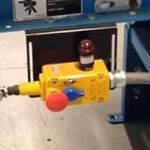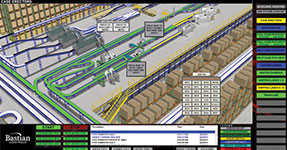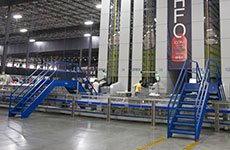
Understanding OSHA Safety Standards for Conveyor
Greg Conner | 09 May 2018
Disclaimer: Official OSHA standards should always be double checked and confirmed to account for any changes that may have occurred since this post was made.
Each year thousands of people are injured in warehouse accidents involving conveyor. In fact, according to DC Velocity they are responsible for between 9,000 and 10,000 accidents and 30 to 40 deaths annually. One conservative estimate pegs the total number of lost workdays resulting from warehouse accidents at whopping 95 million. If that isn’t bad enough, toss in an average direct cost to a company for a warehouse accident at between $38,000 and $150,000 and it’s clear that warehouse accidents can be a big problem. The Occupational Safety and Health Administration (OSHA) has published general guidelines for conveyor safety. As you will see below these guidelines are very high level and limited. In many cases, local municipalities and/or the equipment manufacturers will require standards above and beyond be met. Conveyor equipment can be extremely dangerous if not used in the proper manner and with necessary safety precautions in place. In addition to the OSHA construction safety standards for conveyor described below, we will also discuss additional conveyor safety guidelines recommended by Bastian Solutions.
OSHA and ASME B20.1 Safety Standard for Conveyors and Related Equipment
General conveyor safety requirements
ASME B20.1 - 5.11 Controls
 Means for stopping the motor or engine shall be provided at the operator's station. Conveyor systems shall be equipped with an audible warning signal to be sounded immediately before starting up the conveyor. An audible horn should sound for a duration of 3-5 seconds before a conveyor system starts. In addition, Bastian Solutions programs all of our system-start buttons so that they must be continuously depressed for the full 3-5 second period that the warning horn is sounding before the conveyor(s) are energized.
Means for stopping the motor or engine shall be provided at the operator's station. Conveyor systems shall be equipped with an audible warning signal to be sounded immediately before starting up the conveyor. An audible horn should sound for a duration of 3-5 seconds before a conveyor system starts. In addition, Bastian Solutions programs all of our system-start buttons so that they must be continuously depressed for the full 3-5 second period that the warning horn is sounding before the conveyor(s) are energized.
If the operator's station is at a remote point, similar provisions for stopping the motor or engine shall be provided at the motor or engine location. For areas of the system not in close proximity to an operator workstation, Bastian Solutions utilizes emergency stop switches and pullcords. All emergency stop circuits should fail in the event of a power loss to the emergency stop circuit. Large systems can be broken up into multiple emergency stop circuits, and a general rule of thumb is that an operator should be able to stop any conveyor within his or her line of sight by activating the nearest emergency stop.

Emergency stop switches shall be arranged so that the conveyor cannot be started again until the actuating stop switch has been reset to running or "on" position. Bastian Solutions designs our controls systems so that a system restart requires two things:
- The emergency stop switch or pull cord that has been triggered must be reset.
- A conveyor start button must be activated.
Depending upon the size of the system, multiple system start buttons may be located throughout the system. Most electrical control panels will also have a system start button as well. At Bastian Solutions, our systems are provided with a HMI (Human Machine Interface). These graphical representations allow operators to quickly identify the location of the tripped emergency stop. Once the local emergency stop has been reset, our systems can be remotely restarted via our HMI. This is a very helpful and time-saving feature.

OSHA 29 CFR 1910.212(a) and ASME B20.1 - 5.9 Guards and Guarding
All exposed moving machinery parts that present a hazard to personnel shall be guarded. It is extremely important that all guarding supplied by the manufacturer be regularly inspected to ensure it is performing its desired duty. A common field observation we see is machinery guarding that is not reinstalled after maintenance is performed. It only takes a few seconds for a serious accident to occur when guarding is not in place.
 Where a conveyor passes over work areas, aisles, or thoroughfares, suitable guards shall be provided to protect employees required to work below the conveyors. Bastian Solutions strongly recommends that conveyor safety nets and other safe guards be installed on overhead conveyors. Even small, light boxes can cause significant injury if they were to fall on an unsuspecting bystander. Safety netting and other safe guards require engineering, and our team of experts has many years of industry experience to help you through the selection process.
Where a conveyor passes over work areas, aisles, or thoroughfares, suitable guards shall be provided to protect employees required to work below the conveyors. Bastian Solutions strongly recommends that conveyor safety nets and other safe guards be installed on overhead conveyors. Even small, light boxes can cause significant injury if they were to fall on an unsuspecting bystander. Safety netting and other safe guards require engineering, and our team of experts has many years of industry experience to help you through the selection process.
OSHA 29 CFR 1910 Subpart E and ASME B20.1 - 5.10 Headroom
 All crossovers, aisles, and passageways shall be conspicuously marked by suitable signs, as required by Subpart E of this part. Egress is a very important safety consideration when designing systems. Specific regulations will vary by municipality, but the overarching design objective is to ensure that workers have the ability to get out of the facility as quickly and safely as possible in the event of an emergency. Exit pathways should be clearly marked. There are several different methods to crossing a conveyor line. The most accepted is a conveyor crossover. A conveyor crossover is just what the name implies, a platform separated by two sets of stairs in which an operator literally crosses over the conveyor. Standards for conveyor crossovers will vary by municipality. However, the most widely accepted designs will meet or exceed the International Building Code (IBC). In some cases, a ships ladder design is acceptable. This is similar to a conveyor crossover, with the stairs being replaced with ladders. Conveyor step overs are not a common method to safely cross a conveyor line because they rely on the operator literally stepping over or on the conveyor when crossing. Conveyor lift gates are also commonly used to cross conveyors. However, since they require operators to physically lift a gate and if not controlled properly could have product accumulated on them, are not usually recommend or accepted in egress paths.
All crossovers, aisles, and passageways shall be conspicuously marked by suitable signs, as required by Subpart E of this part. Egress is a very important safety consideration when designing systems. Specific regulations will vary by municipality, but the overarching design objective is to ensure that workers have the ability to get out of the facility as quickly and safely as possible in the event of an emergency. Exit pathways should be clearly marked. There are several different methods to crossing a conveyor line. The most accepted is a conveyor crossover. A conveyor crossover is just what the name implies, a platform separated by two sets of stairs in which an operator literally crosses over the conveyor. Standards for conveyor crossovers will vary by municipality. However, the most widely accepted designs will meet or exceed the International Building Code (IBC). In some cases, a ships ladder design is acceptable. This is similar to a conveyor crossover, with the stairs being replaced with ladders. Conveyor step overs are not a common method to safely cross a conveyor line because they rely on the operator literally stepping over or on the conveyor when crossing. Conveyor lift gates are also commonly used to cross conveyors. However, since they require operators to physically lift a gate and if not controlled properly could have product accumulated on them, are not usually recommend or accepted in egress paths.
OSHA 29 CFR 1910.147(c)
 Conveyors shall be locked out or otherwise rendered inoperable, and tagged out with a "Do Not Operate" tag during repairs and when operation is hazardous to employees performing maintenance work. Not properly locking out and tagging conveyors is one of the most common culprits of serious injury and death in warehouses and manufacturing facilities. Many of these facilities are extremely large, and it is common for the conveyor that is being worked on to be located in an area that is not visible from the electrical control panel. Not rendering the conveyor inoperable while servicing it is a recipe for disaster.
Conveyors shall be locked out or otherwise rendered inoperable, and tagged out with a "Do Not Operate" tag during repairs and when operation is hazardous to employees performing maintenance work. Not properly locking out and tagging conveyors is one of the most common culprits of serious injury and death in warehouses and manufacturing facilities. Many of these facilities are extremely large, and it is common for the conveyor that is being worked on to be located in an area that is not visible from the electrical control panel. Not rendering the conveyor inoperable while servicing it is a recipe for disaster.
All conveyors in use shall meet the applicable requirements for design, construction, inspection, testing, maintenance, and operation, as prescribed in the ANSI B20.1, Safety Code for Conveyors, Cableways, and Related Equipment. Safety standards are ever changing, and it is extremely important that facility managers ensure their systems are following the latest standards. Most equipment manufacturers post their safety standards on their website. Conveyor Equipment Manufacturers Association (CEMA) is also a great resource for staying current on the latest safety practices.
Greg is the SVP of Corporate Development and Marketing at Bastian Solutions. A proud Purdue University graduate, at Bastian he works to identify and drive strategies to propel the company forward. His responsibilities include identification of emerging technologies, forming strategic partnerships and M&A activities and execution of the strategic planning process. He carries with him years of experience in the field, having previously worked as a project engineer, field application engineer and regional director of Indiana.
Comments
Mark Akers says:
5/30/2019 11:25 AM
Question about safety clearance or pinch point for a product traveling on an overhead monorail conveyor. Not vertical clearance but when product is at a low level while traveling around a column. Where is the OSHA code for this?
David Stewart says:
6/14/2019 01:50 AM
Outstanding blog. OSHA Safety Standards for Conveyor
are very useful. I always follow OSA standards. OSHA provides rules and regulations for many industries.
Henrik Gustafsson says:
10/4/2019 08:23 AM
Does the 1926.555(a) adress fire risk as well?
Leave a Reply
Your email address will not be published.
Comment
Thank you for your comment.